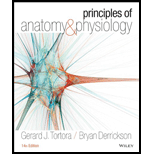
Principles of Anatomy and Physiology
14th Edition
ISBN: 9781118345009
Author: Gerard J. Tortora
Publisher: WILEY
expand_more
expand_more
format_list_bulleted
Question
Chapter 26, Problem 26CP
Summary Introduction
To review:
The role of liver as well as lungs in the waste elimination from the body.
Introduction:
The urinary system of the body functions in eliminating the waste product from the body. Other than the urinary system, there are other tissue and organs that contribute to the process of excretion of waste materials or toxic substances from the body.
Expert Solution & Answer
Want to see the full answer?
Check out a sample textbook solution
Students have asked these similar questions
What are the structure and properties of atoms and chemical bonds (especially how they relate to DNA and proteins).
The Sentinel Cell: Nature’s Answer to Cancer?
Molecular Biology Question
You are working to characterize a novel protein in mice. Analysis shows that high levels of the primary transcript that codes for this protein are found in tissue from the brain, muscle, liver, and pancreas. However, an antibody that recognizes the C-terminal portion of the protein indicates that the protein is present in brain, muscle, and liver, but not in the pancreas. What is the most likely explanation for this result?
Chapter 26 Solutions
Principles of Anatomy and Physiology
Ch. 26 - Prob. 1CPCh. 26 - Prob. 2CPCh. 26 - Prob. 3CPCh. 26 - Prob. 4CPCh. 26 - 10. Where is the juxtaglomerular apparatus (JGA)...Ch. 26 - How do tubular reabsorption and tubular secretion...Ch. 26 - Prob. 7CPCh. 26 - What is the major chemical difference between...Ch. 26 - Prob. 9CPCh. 26 - Prob. 10CP
Ch. 26 - How is glomerular filtration rate regulated?Ch. 26 - Prob. 12CPCh. 26 - Describe two mechanisms in the PCT, one in the...Ch. 26 - 19. How do intercalated cells secrete hydrogen...Ch. 26 - Graph the percentages of filtered water and...Ch. 26 - 21. How do symporters in the ascending limb of the...Ch. 26 - 22. How does ADH regulate facultative water...Ch. 26 - Prob. 18CPCh. 26 - What are the characteristics of normal urine?Ch. 26 - Prob. 20CPCh. 26 - How may kidney function be evaluated?Ch. 26 - Prob. 22CPCh. 26 - What forces help propel urine from the renal...Ch. 26 - What is micturition? How does the micturition...Ch. 26 - 30. How do the location, length, and histology of...Ch. 26 - Prob. 26CPCh. 26 - Prob. 27CPCh. 26 - Which tissue gives rise to collecting ducts,...Ch. 26 - 34. To what extent do kidney mass and filtration...
Knowledge Booster
Learn more about
Need a deep-dive on the concept behind this application? Look no further. Learn more about this topic, biology and related others by exploring similar questions and additional content below.Similar questions
- Molecular Biology Explain/discuss how “slow stop” and “quick/fast stop” mutants wereused to identify different protein involved in DNA replication in E. coli.arrow_forwardMolecular Biology Question A gene that codes for a protein was removed from a eukaryotic cell and inserted into a prokaryotic cell. Although the gene was successfully transcribed and translated, it produced a different protein than it produced in the eukaryotic cell. What is the most likely explanation?arrow_forwardMolecular Biology LIST three characteristics of origins of replicationarrow_forward
- Molecular Biology Question Please help. Thank you For E coli DNA polymerase III, give the structure and function of the b-clamp sub-complex. Describe how the structure of this sub-complex is important for it’s function.arrow_forwardMolecular Biology LIST three characteristics of DNA Polymerasesarrow_forwardMolecular Biology RNA polymerase core enzyme structure contains what subunits? To form holo enzyme, sigma factor is added to core. What is the name of the structure formed? Give the detailed structure of sigma factor and the function of eachdomain. Please help. Thank youarrow_forward
- Molecular Biology You have a single bacterial cell whose DNA is labelled with radioactiveC14. After 5 rounds of cell division, how may cells will contain radioactive DNA? Please help. Thank youarrow_forward1. Explain the structure and properties of atoms and chemical bonds (especially how they relate to DNA and proteins). Also add some pictures.arrow_forward1. In the Sentinel Cell DNA integrity is preserved through nanoscopic helicase-coordinated repair, while lipids in the membrane are fortified to resist environmental mutagens. also provide pictures for this question.arrow_forward
- Explain the structure and properties of atoms and chemical bonds (especially how they relate to DNA and proteins). Also add some pictures.arrow_forwardIn the Sentinel Cell DNA integrity is preserved through nanoscopic helicase-coordinated repair, while lipids in the membrane are fortified to resist environmental mutagens. also provide pictures for this question.arrow_forward1. Explain how genetic information is stored, copied, transferred, and expressed. Also add some pictures for this question.arrow_forward
arrow_back_ios
SEE MORE QUESTIONS
arrow_forward_ios
Recommended textbooks for you
 Human Physiology: From Cells to Systems (MindTap ...BiologyISBN:9781285866932Author:Lauralee SherwoodPublisher:Cengage Learning
Human Physiology: From Cells to Systems (MindTap ...BiologyISBN:9781285866932Author:Lauralee SherwoodPublisher:Cengage Learning Human Biology (MindTap Course List)BiologyISBN:9781305112100Author:Cecie Starr, Beverly McMillanPublisher:Cengage Learning
Human Biology (MindTap Course List)BiologyISBN:9781305112100Author:Cecie Starr, Beverly McMillanPublisher:Cengage Learning- Lifetime Physical Fitness & WellnessHealth & NutritionISBN:9781337677509Author:HOEGERPublisher:Cengage

Human Physiology: From Cells to Systems (MindTap ...
Biology
ISBN:9781285866932
Author:Lauralee Sherwood
Publisher:Cengage Learning


Human Biology (MindTap Course List)
Biology
ISBN:9781305112100
Author:Cecie Starr, Beverly McMillan
Publisher:Cengage Learning


Lifetime Physical Fitness & Wellness
Health & Nutrition
ISBN:9781337677509
Author:HOEGER
Publisher:Cengage

Human digestive system - How it works! (Animation); Author: Thomas Schwenke;https://www.youtube.com/watch?v=X3TAROotFfM;License: Standard Youtube License